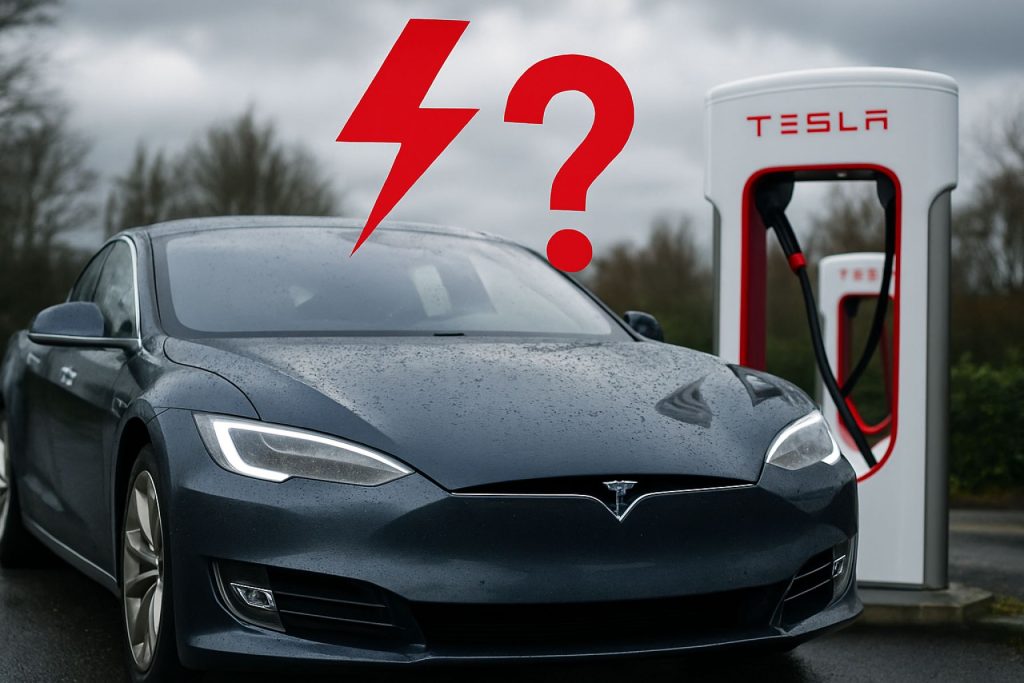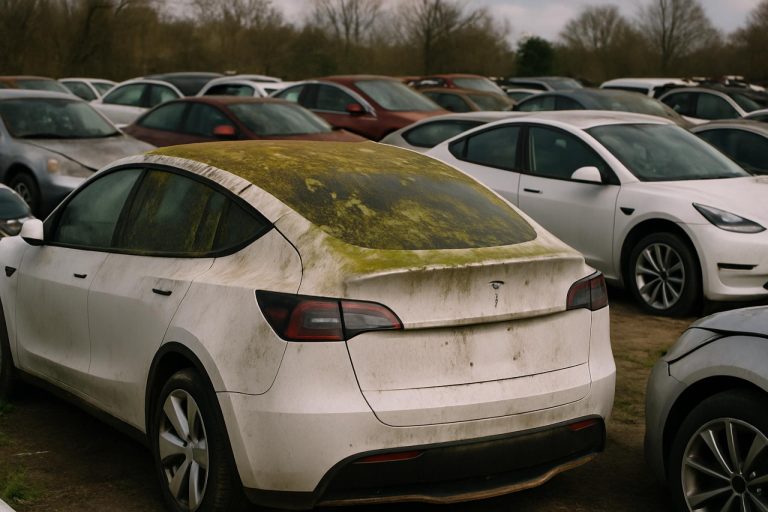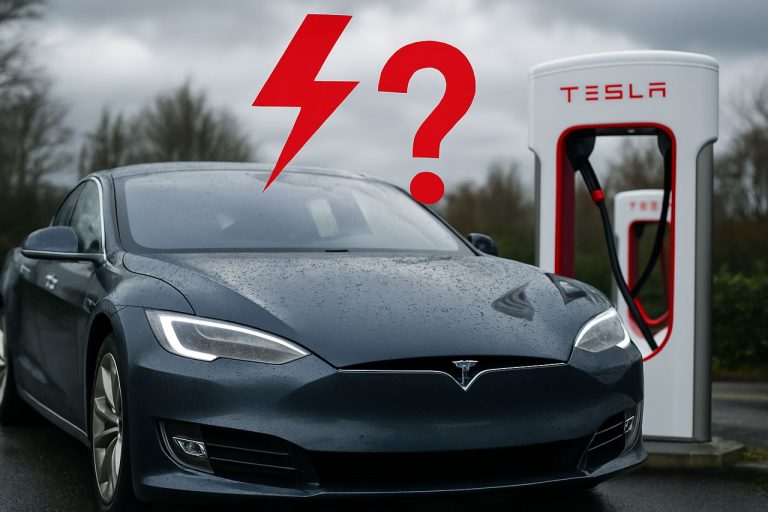
- The electric vehicle (EV) market is evolving rapidly, with increased competition from established automakers like Ford overtaking Tesla’s Cybertruck in key sales metrics.
- Tesla faces declining resale values, including a sharp 46% drop for used Cybertrucks and falling prices across its lineup, raising concerns about the brand’s long-term appeal.
- Policy shifts, such as changes to leasing and “robotaxi” promises, have led to customer confusion and mistrust in Tesla’s leadership.
- External challenges, including trade tariffs and public controversies surrounding CEO Elon Musk, add to investor uncertainty and unrest.
- Tesla’s strengths in EV technology and infrastructure remain unmatched, but competitors’ advances and market missteps threaten its leading position.
Tesla once captivated the world, making electric cars not just practical but fashionable—a symbol of transformation and ambition. But the current mood swirling around the company resembles a summer storm: unpredictable, charged, and carrying the scent of hard truths. Long-time believers, confident that Tesla would remain the unequivocal leader in electric mobility, now find themselves questioning that faith.
A series of recent setbacks have raised eyebrows among investors and everyday drivers alike. The company’s decision to change its leasing policy, once rooted in visionary talk of “robotaxis,” has created a ripple effect of confusion and mistrust. When customers discovered they could no longer purchase their leased Teslas, many believed it was because the company needed vehicles for its long-promised autonomous fleet. Yet, as those dreams of highways filled with driverless Teslas faded into the background, reports emerged of the company reselling upgraded off-lease vehicles—often at a premium—to new buyers, rather than to the original lessees. This maneuver, explained as a strategy for the future, feels to many like a broken promise.
At the heart of this disquiet is the Cybertruck, Tesla’s brash, futuristic gamble that seemed poised to revolutionize pickup trucks. Instead, the numbers paint a different picture: sluggish sales, slashed prices, and a market cooling to its stainless-steel bravado. Data from industry analysts shows that while average prices of all electric vehicles crept downward modestly, used Cybertruck values plummeted by a staggering 46% over the past year. Even Tesla’s more mainstream Model Y isn’t immune, with prices dropping more than 14%—a sign the brand’s cachet might be eroding faster than expected.
Meanwhile, America’s best-selling vehicle—the Ford F-150—now wears the electric crown with its Lightning model. In the most recent quarter, Ford outsold the much-hyped Cybertruck by nearly 800 registrations, according to numbers tracked by S&P Global Mobility. The significance is hard to overstate: Tesla, which sold its brand as the spearhead of the next automotive era, finds its latest product overtaken by Detroit’s old guard.
For many watching Tesla, unease grows from mounting headwinds. Trade tensions—with new tariffs targeting electric vehicles and battery imports—threaten Tesla’s delicate supply chains. Add to this a maelstrom of public scrutiny and consumer protests, often aimed as much at CEO Elon Musk’s political theatrics as at the cars themselves. Investors are left to wonder how much patience even the most loyal shareholders will afford.
Yet, history reminds us that markets—as well as companies built on grand visions—do not linger in gloom indefinitely. Tesla remains a dominant force in EV technology and infrastructure, with products, patents, and a passionate customer base that many competitors envy. Its pioneering efforts in over-the-air software updates and rapid charging still set industry standards.
But those assets won’t shield it forever from the consequences of missteps, whether perceived or real. The electric vehicle landscape is evolving. Ford, General Motors, and others charge forward with new models, competitive pricing, and aggressive marketing strategies—making the market more crowded and competitive by the day.
Consumers and investors, wary of uncertainty, should watch closely as Tesla navigates this crucial crossroad. The company’s next moves—whether a return to its innovative spirit, a new leap in autonomous technology, or a course correction in its approach to trust—will shape not only its fate but the trajectory of the entire EV revolution.
Takeaway: Even icons can stumble. For Tesla, restoring trust and momentum is not just a matter of tweaking prices or models—it’s about rekindling the belief that shaped its rise. The road ahead is uncertain, but the stakes for the future of electric vehicles could not be higher.
For deeper industry perspectives, visit Bloomberg and CNBC.
Tesla in Turmoil: What EV Shoppers and Investors MUST Know Before Making Their Next Move
Tesla’s Turbulent Times: Unveiling the Full Story Behind Its EV Woes
Tesla has long stood as the poster child for electric vehicle revolution and innovation. However, underneath its shiny exterior, the company faces mounting challenges—some brewing for years and others coming to a head in 2024. Here’s the deeper story, based on industry expertise and the latest trends, that expands significantly beyond recent headlines.
—
Additional Facts and Insider Analysis
1. Cybertruck’s Real-World Limitations
– Feature Shortfalls: The much-anticipated Cybertruck, despite its distinct design, faces reliability concerns. Owners have reported issues such as malfunctioning doors, problematic wiper mechanisms, and inconsistent charging experiences ([Car and Driver](https://www.caranddriver.com)).
– Spec Disappointments: The Cybertruck was initially promised with up to 500+ miles of range, but real-world tests repeatedly fall short, with many deliveries offering significantly less range, especially under heavy towing conditions.
– Pricing Surprises: Tesla adjusted prices for the Cybertruck post-launch, with flagship models costing well above the initially hyped price points. This stirred discontent among early deposit holders.
2. Tesla’s Market Share and Challenges
– Declining Share: Tesla’s share of the US EV market fell from approximately 70% in 2021 to roughly 50% in early 2024 (S&P Global Mobility).
– Aggressive Competition: Legacy automakers like Ford, Hyundai, Kia, and Chinese entrants (BYD) are rolling out competitive EVs at scale and lower price points, forcing Tesla to continually trim its margins.
– Global Supply Chain Issues: New tariffs by the U.S. and China threaten not only Tesla’s profit margins but also its critical battery supply chains.
3. The Leasing Policy Fallout
– Customer Backlash: The abrupt end to the policy allowing leasers to buy out their Teslas at the end of term enraged many longtime fans. This undermined Tesla’s previous promise of consumer empowerment and feeds negative sentiment on platforms like Reddit and X (Twitter), hurting the brand.
– Residual Value Concerns: Shifting lease strategies combined with used vehicle price drops have created uncertainty over Tesla’s long-touted resale value advantage.
4. Autopilot & Full Self-Driving (FSD) Controversies
– Ongoing Investigations: Tesla’s Autopilot and FSD features are currently under scrutiny from the NHTSA due to high-profile accidents and fatalities, feeding skepticism about automation promises ([NHTSA](https://www.nhtsa.gov)).
– Feature Delays: FSD remains in “beta” after years of high-profile projections. This has led to multiple lawsuits and consumer complaints about misleading advertising regarding its self-driving capabilities.
5. Leadership & Perception Risks
– CEO Publicity: Elon Musk’s polarizing behavior on social media and involvement in political controversies has spilled over into consumer perception and trust.
– Employee Turnover: High levels of executive and engineer departures in 2023-2024 have been documented, raising concerns about continuity and innovation at Tesla.
—
How-To: Steps for Navigating Tesla’s Current Landscape
1. Research Before Buying or Leasing: Scrutinize current Tesla pricing and residuals on third-party sites and EV forums.
2. Understand Lease Terms: For those considering a Tesla lease, confirm all end-of-term policies in writing.
3. Compare Alternatives: Review head-to-head EV reviews vs. Ford Lightning, Hyundai IONIQ 5, and others.
4. Watch Regulatory News: Follow updates on self-driving regulations and recalls.
5. Anticipate Depreciation: Expect rapid value changes in both new and used Teslas over the next 12-24 months.
—
Real-World Use Cases & Market Insights
– Fleets & Businesses: Many commercial operators, initially bullish on Tesla for their fleets, are now exploring Ford and GM for reliability and service support.
– Home Charging Networks: Tesla’s Supercharger network remains a market leader, but other automakers striking deals for charging interoperability could narrow this edge by 2025 (as reported by Bloomberg).
—
Pros and Cons Overview
Pros:
– Best-in-class charging ecosystem
– Frequent over-the-air updates
– Strong battery technology (still industry-leading for range)
Cons:
– Volatile resale values
– Customer service bottlenecks
– Ongoing autonomy and safety controversies
– Increasing competition with better warranty and service terms
—
Limitations & Controversies
– Software-First Design Risks: Tesla’s reliance on software updates occasionally creates unexpected changes to vehicle features, sometimes annoying customers.
– Limited Repair Network: Service delays have been cited as a frequent frustration compared to legacy automakers.
– Quality Consistency: Manufacturing issues, like panel gaps and paint problems, still pop up in owner forums and third-party reviews.
—
FAQs: The Most Pressing Tesla Questions Answered
Q: Is Tesla still the best EV choice for most drivers in 2024?
A: Not necessarily. While the Supercharger network is a big advantage, buyers focused on customer support, price stability, and reliability may find better value elsewhere.
Q: What’s happening with Tesla’s “self-driving” features?
A: Despite regular software releases, no Tesla is fully autonomous. Regulatory approval and safety remain key roadblocks.
Q: Are Cybertruck prices and reliability likely to improve?
A: The market signals caution, as used values are dropping and initial owner feedback is mixed. Improvements are expected, but timeline remains uncertain.
Q: Is Tesla a safe investment right now?
A: Tesla remains innovative, but risks are higher than in recent years due to competitive, regulatory, and brand challenges. Diversify and follow industry news closely.
—
Actionable Recommendations & Quick Tips
– Compare Before You Buy: Check out recent owner satisfaction ratings from sources like J.D. Power and Consumer Reports.
– Track Used Prices: Use tools like Kelley Blue Book or Edmunds to watch how Cybertruck and Model Y values shift.
– Sign Up for Recalls: Ensure your Tesla stays updated and safe with official NHTSA notifications ([NHTSA](https://www.nhtsa.gov)).
– Follow Industry News: Trusted sources like CNBC and Bloomberg provide up-to-date analysis and prediction.
—
The Bottom Line: Stay Data-Driven
Tesla’s future is not written in stone. Whether you’re a consumer or investor, staying informed, asking hard questions, and comparing all your options is the smartest path in this rapidly changing EV landscape.



